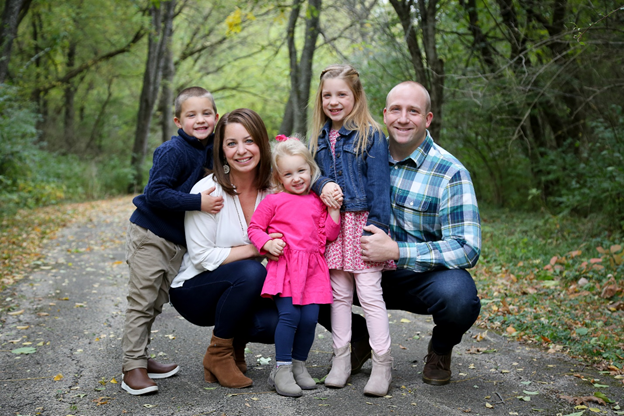Chaos, commotion, and fun
Living with a big family during e-learning
Photo by and used with permission of Brittany O’Hagan
Living in a big family requires a precise schedule to coordinate through the day. “I started at 8:00am and I taught periods one through three, and then eight and nine, so I had the middle of the day off, which was nice because I was able to eat lunch with my kids and spend some time with them,” Meghan Reynolds, English teacher and mother of three kids, said. “For my kids, my six-year-old and my seven-year-old, they started at 8:30. They were live with their teacher, sitting in front of their computer, for five to six hours a day, so similar to me; it worked out because we had the middle of the day off together, which was nice.”
The average American family consists of about three people as of 2020, according to Statista.com, but with these families of five and eight, there is a sizable struggle when it comes to e-learning.
For Anna Lutz, junior who has five older siblings, the challenge of e-learning was not just about how to make it through a school year when she could not be at school; she also had to manage her crowded household.
“My parents have six kids, all having different issues, so I understand how tough it must be to give everyone their own attention,” said Lutz. “We have WiFi issues depending on how many of us kids are home. If we have WiFi issues, my parents will contact the school and warn them, or we have to use our phone hotspots if they work.”
Lutz says she chose e-learning because she finds it “easier to focus not being with multiple other students”. With her many siblings, Lutz finds she has a distinct advantage because she has help along the way.
“Having older siblings helps because they always give me advice [since they] have been through high school and friends. I always have someone there to help me with anything from homework to advice, and anything in between,” Lutz said. “I love that they can help me because obviously it’s harder to ask for help from teachers during e-learning when you have other stuff going on.”
Because her siblings are older, Lutz says she is able to ask them for help when she need it as “it is more convenient” rather than asking her busy teachers.
“It’s easy to get help with any of my classes with them home because at least one of them always knows how to do something that I need help with,” Lutz said. “Also, it’s nice to have people to still socialize with since I’m not exactly in school around other classmates.”
In fact, Lutz says one of her major concerns regarding e-learning was the lack of socializing because everyone was required to stay home.
“My biggest [fear] with e-learning was that I wasn’t going to be seeing my friends and classmates on a daily basis,” Lutz said. “I didn’t know how that would affect my social life, but having people with me at home really helps.”
But living in a big family does have its hardships during e-learning. Meghan Reynolds, English teacher and mother of three children, says her experience was “chaotic, busy, and overwhelming” as she had to balance teaching and parenting.
“I think when I was home, it was most chaotic just because there were three of us; I was trying to teach and my two older children were trying to listen to their teachers and learn,” Reynolds said. “They were on Google Classroom and my boy, Shane – he is in kindergarten – needs one-on-one support. Luckily I had my mother in law there who was able to help, but then I also have my three-year-old who wants attention. There was often a lot of crying [and] temper tantrums.”
Fortunately for Reynolds, “many of the temper tantrums did not happen in the middle of [her] teaching,” which allowed her to finish teaching her students, then helping her kids.
“I would be sitting down with usually my son, Shane, and just talking to him about how he was feeling, why he was upset, why he was frustrated, and trying to get him to understand why he was feeling that way,” Reynolds said. “We needed to figure out a way for him to stand up, and release some energy and frustration because sitting in front of a computer for a five and six-year-old all day was just really rough for him.”
The biggest advantage Reynolds said she had during e-learning was being able to help her kids through difficult situations when they needed her in order to “be a part of their learning, and keep them motivated and focused,” although it was difficult to find a balance between teaching and parenting.
“It’s hard as a teacher because my job is a priority in my life and it’s what helps support my family, but at the same time, my children are my priority, so trying to balance that and trying to compromise those two priorities in my life was really hard for me,” Reynolds said. “That was very frustrating because I couldn’t be the mom and the teacher at the same time, and it kind of gave me this feeling of guilt almost. In a way, I’m their mom and I should be there for them, but I have my own students I need to support, I have my own classroom that I need to run, so finding that balance was the disadvantage of being home.”

This is Sasha’s third and final year working with the Bear Facts staff as the LZ Life Editor. Aside from helping Bear Facts run smoothly, you can find...

